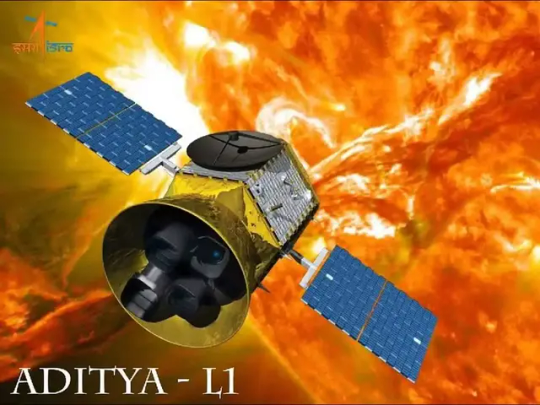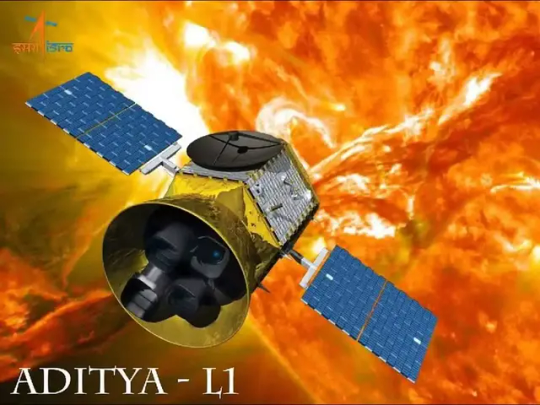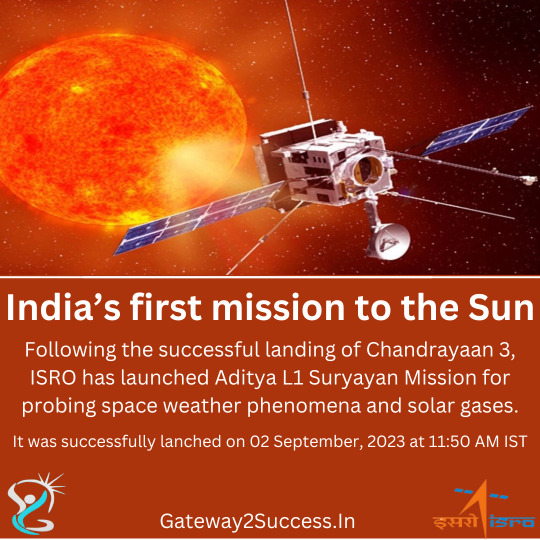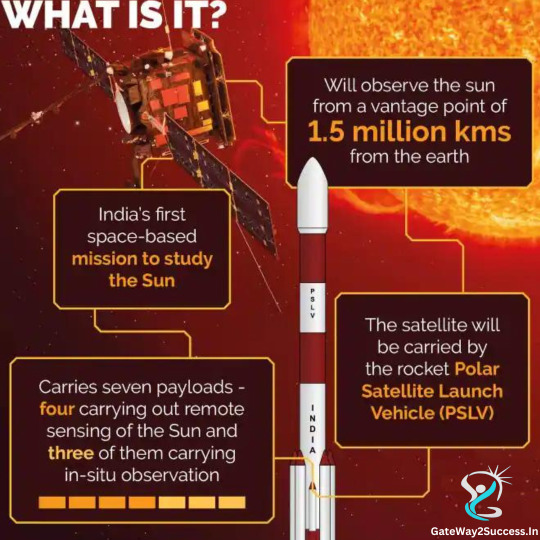#Aditya-L1 carries seven payloads
Explore tagged Tumblr posts
Text
Aditya-L1: India's Pioneering Solar Mission Set to Enter Orbit Today
Introduction: In a significant milestone for India’s space exploration endeavors. The Indian Space Research Organisation’s (ISRO) Aditya-L1 To Enter Orbit today mission, the nation’s first solar observation mission, is poised to reach its final destination orbit today. Launched on September 2, 2023, from ISRO’s Sriharikota launchpad. The Aditya-L1 mission is a testament to India’s commitment to…

View On WordPress
#Aditya-L1 carries seven payloads#Aditya-L1 mission#Aditya-L1 To Enter Orbit today#Indian Space Research Organisation&039;s (ISRO)
0 notes
Text
Aditya-L1: India's Pioneering Solar Mission Set to Enter Orbit Today
Introduction: In a significant milestone for India’s space exploration endeavors. The Indian Space Research Organisation’s (ISRO) Aditya-L1 To Enter Orbit today mission, the nation’s first solar observation mission, is poised to reach its final destination orbit today. Launched on September 2, 2023, from ISRO’s Sriharikota launchpad. The Aditya-L1 mission is a testament to India’s commitment to…

View On WordPress
#Aditya-L1 carries seven payloads#Aditya-L1 mission#Aditya-L1 To Enter Orbit today#Indian Space Research Organisation&039;s (ISRO)
0 notes
Text


Gate Way to Success - ISRO Aditya L1 Suryayan Mission Launched
Even as Mission Chandrayaan-3 is sending some interesting information related to Moon every other day, ISRO's next mission, PSLV-C57/Aditya-L1 Mission, aimed at conducting research about Sun, is set to launch on Saturday (September 2, 2023). The 24-hour countdown of the sun mission has begun. In a tweet that Indian Space Research Organisation (ISRO) posted on Friday (September 1, 2023), it said, "The 23-hour 40-minute countdown leading to the launch at 11:50 Hrs. IST on September 2, 2023, has commended today at 12:10 Hrs."
On 02nd September, 2023 at 11:50 AM IST; ISRO successfully launched the Aditya L1 mission, marking another significant achievement after their recent Chandrayan 3 lunar expedition. The launch took place from the Satish Dhawan Space Centre on the Eastern coast, and the Polar Satellite Launch Vehicle (PSLV) had its longest flight, lasting approximately 63 minutes.
Aditya-L1 is a space-based observatory designed to study the Sun. After a 125-day journey covering about 1.5 million kilometres from Earth, the spacecraft will be positioned in a Halo orbit around Lagrangian point L1, which is the point closest to the Sun. Amongst its scientific objectives, the mission will capture images of the Sun for research purposes.
The mission's primary objectives include understanding Coronal Heating, Solar Wind Acceleration, the initiation of Coronal Mass Ejection (CME), near-earth space weather, and solar wind distribution. Aditya-L1 carries seven scientific payloads, including the Visible Emission Line Coronagraph (VELC), which will capture images of the solar corona and CME dynamics, making it the largest and most technically challenging payload on the mission. Other instruments, such as the Solar Ultraviolet Imaging Telescope, Aditya Solar Wind Particle Experiment (ASPEX), Plasma Analyser Package for Aditya (PAPA), Solar Low Energy X-ray Spectrometer, High Energy L1 Orbiting X-ray Spectrometer (HEL1OS), and Magnetometer, will provide valuable data on various aspects of the Sun's behaviour.
All of the scientific payloads on Aditya-L1 have been developed within ISRO's research centres through close collaboration, showcasing India's expertise in space research and exploration.
Go to Our to the given links to Support us- #WhatsApp- +91 8851135978, #Gmail- [email protected], #Website- Gateway2Success.In
#delhi#noida#indirapuram#india#govtjobs#mbbsadmission#gateway2success#government#rakshasa#gatewaytosuccess#rakshak#delhincr#ISRO#isroindia#isromissions#isromoonmission#chandrayaan#chandrayaan 3#chandrayaanlaunch#chandrayaan isro#moon mission#aditya l1
0 notes
Video
youtube
Aditya L1 is carrying seven different payloads to have a detailed study of the Sun
0 notes
Link
India’s space program will continue its busy 2023 with the launch of its first solar research mission, Aditya-L1, on Saturday. Liftoff, aboard the country’s Polar Satellite Launch Vehicle (PSLV) XL rocket, is expected at 11:50 Indian Standard Time (06:20 UTC) from the Satish Dhawan Space Centre. Aditya-L1 will be the first mission conducted by the Indian Space Research Organisation (ISRO) that is dedicated to studying the Sun. Bound for the Earth-Sun L1 Lagrange point, it will also be the first Indian spacecraft to operate at this location. ISRO expects the mission to contribute to global research into the Sun, with a focus on space weather and the solar wind. Key science objectives for the mission are to help increase understanding of the phenomena of coronal heating, or how the Sun’s corona – its outer atmosphere – has a far higher temperature than the surface of the Sun itself, and study how the corona accelerates the solar wind. Other major objectives include understanding how solar flares and coronal mass ejections are initiated, studying the dynamics of the Sun’s atmosphere, and monitoring the distribution and anisotropy (lack of uniformity by direction) of particles in the solar wind. Saturday’s launch comes just ten days after ISRO celebrated another major milestone with the successful landing of its Vikram probe on the Moon as part of the Chandrayaan-3 mission. With the agency having already carried out the first successful launch of its new Small Satellite Launch Vehicle rocket earlier this year, and now gearing up for the first uncrewed test flight of its Gaganyaan crew capsule in early 2024, this is an important time for India in space. Aditya-L1 carries a suite of seven instruments that will be used to study the Sun. The spacecraft was constructed in-house at ISRO and has a mass of 1,475 kilograms. It is expected to operate for at least five years. The main instrument is the Visible Emission Line Coronagraph, which was built by the Indian Institute of Astrophysics to study the Sun’s corona and coronal mass ejection events. It uses an internally occulted reflective coronagraph to block direct light from the Sun itself to allow its detectors – including an imager, a multi-split spectrograph, and a polarimeter, to observe the corona. See AlsoPSLV C57 UpdatesNSF StoreISRO Forum SectionClick here to Join L2 The Solar Ultraviolet Imaging Telescope was developed by the Inter-University Centre for Astronomy and Astrophysics. Its purpose is to make observations of the full disc of the Sun at near-ultraviolet wavelengths — allowing for study of the photosphere and chromosphere, as well as measuring fluctuations in the amount of ultraviolet light radiated by the sun. ISRO’s U R Rao Satellite Centre has contributed a pair of x-ray imaging payloads to the mission: the Solar Low Energy X-ray Spectrometer (SoLEXS) and the High Energy L1 Orbiting X-ray Spectrometer (HEL1OS). These will be used to help study solar flares, with SoLEXS observing soft, or lower-energy, x-ray emissions and HEL1OS focussing on hard, or high-energy, emissions. Aditya Solar Wind Particle Experiment (ASPEX) was built by the Physical Research Laboratory at Ahmedabad to study the solar wind in an effort to unlock a better understanding of processes within the Sun. It consists of two sensors: the Solar Wind Ion Spectrometer, which will be used to detect and measure protons and alpha particles; and the Suprathermal and Energetic Particle Spectrometer, which will detect higher-energy ions. Aditya-L1 atop PSLV C57’s fourth stage, shortly before being enclosed in the payload fairing. (Credit: ISRO) The Plasma Analyser Package for Aditya (PAPA), developed by the Vikram Sarabhai Space Centre’s Space Physics Laboratory, will also contribute to Aditya’s study of the solar wind. PAPA consists of a Solar Wind Electron Energy Probe and Solar Wind Ion Composition Analyser to record the flux, density, and composition of electrons and ions in the solar wind, helping to build a detailed record of how these vary over time. By studying particles in the solar wind with ASPEX and PAPA, the Aditya mission may be able to validate theories about how wave-particle interactions might play a role in the processes of solar wind acceleration and coronal heating. The final instrument aboard Aditya, the Magnetometer, will measure the magnetic fields in situ at the spacecraft’s location. Two sets of sensors are mounted on a six-meter deployable boom, with one set at the end of the boom and the other halfway along it, providing two sets of measurements. ISRO will use its PSLV rocket to deploy Aditya-L1 into an initial low-Earth orbit. From here, the spacecraft will, under its own propulsion, perform a series of maneuvers to place itself into a halo orbit around the Earth-Sun L1 Lagrange point. Lagrange points are locations in space where the gravitational pull of two celestial bodies are in equilibrium, allowing objects to remain at, or orbit, the point with minimal station-keeping. Aditya’s journey to the Earth-Sun L1 point. (Credit: ISRO) The Earth-Sun L1 point is located directly between the Earth and the Sun, at about 1.5 million kilometers from Earth. Placing solar research missions at L1 ensures their view of the Sun will not be interrupted by Earth while ensuring the spacecraft also remains relatively close to Earth for communications and data downlink. Upon arrival at the L1 point, Aditya will join four other spacecraft currently operating at L1: the joint NASA-ESA Solar and Heliospheric Observatory, NASA’s Advanced Composition Explorer and Wind missions, and the National Oceanic and Atmospheric Administration’s Deep Space Climate Observatory. Aditya will be the first Indian spacecraft to operate at L1 and is expected to reach its final orbit around the Lagrange point about 125 days after launch. To deploy Aditya-L1, the most powerful version of the PSLV rocket, PSLV-XL, will be employed. This is a four-stage launch vehicle employing both solid and liquid-fuelled propulsion, capable of placing payloads of up to 1,750 kilograms into a 600-kilometer Sun-synchronous orbit or 1,425 kilograms to a geosynchronous transfer orbit. The rocket that will carry Aditya into orbit has been designated with flight number PSLV C57, and will be the fifty-ninth PSLV rocket to fly. The rocket is ISRO’s workhorse, carrying out the majority of the agency’s satellite launches as well as occasional commercial missions. It first flew in September 1993 and had – prior to Saturday’s launch – carried out 55 of its missions successfully, with two failures and one partial failure due to an off-nominal orbit. PSLV’s last 17 missions have all been successful. PSLV C57 leaving the assembly building for the launch pad. (Credit: ISRO) Saturday’s launch will take place from the Second Launch Pad at the Satish Dhawan Space Centre (SDSC) on Sriharikota, a barrier island in the Bay of Bengal. First used in 2005, this launch pad has hosted PSLV, Geosynchronous Satellite Launch Vehicle (GSLV), and GSLV Mk.III (also known as Launch Vehicle Mark 3) launches and is one of two pads available for PSLV missions, along with the nearby First Launch Pad. SDSC has been the site for all of India’s orbital launches to date. PSLV’s first stage is powered by an S-138 solid rocket motor. Depending on the configuration, up to six PS0M-XL solid rocket motors can be attached as boosters to augment its thrust, with PSLV-XL using the full set of six. Once Saturday’s countdown reaches zero, the first stage will ignite, followed by the first two pairs of boosters at T+0.42 seconds and T+0.62 seconds. Climbing away from the SDSC, PSLV will ignite the final pair of boosters around 25 seconds into flight. Separation of the ground-lit boosters will occur around the 70-second mark, while the air-lit boosters will separate about 92 seconds into the mission. About 108 seconds after liftoff, the first stage will have exhausted all of its propellant and will burn out. The spent stage will be jettisoned, and the vehicle’s second stage will take over. Designated PS2, or PL40, the second stage is powered by a single Vikas engine burning hypergolic liquid propellants. Its fuel is UH25, a mixture of three parts unsymmetrical dimethylhydrazine to one part hydrazine hydrate, while its oxidizer is dinitrogen tetroxide. This propellant combination can be stored at room temperature and ignite easily without the need for complex ignition systems on the vehicle; however, they are also toxic and highly flammable. The Vikas engine itself is derived from the Viking engine used on early versions of the European Ariane series of rockets. PSLV’s second stage burn is expected to last about two and a half minutes. While the second stage is firing, the rocket will enter space, and shortly afterward will shed its payload fairing. The fairing, which ISRO calls a “heat shield,” helps to protect the satellite and preserve the rocket’s aerodynamic profile during its ascent through the atmosphere, but is no longer needed once PSLV reaches space and is discarded to reduce the rocket’s weight. PSLV C57 with Aditya-L1, prior to launch. (Credit: ISRO) The third stage, or HPS3, will ignite shortly after the second stage has shut down and separated. This solid-fuelled stage consists of an S-7 motor which will burn for approximately 70 seconds. After burnout, the mission will enter a coast phase as the rocket climbs towards its apogee – or the highest point on its trajectory. Third stage separation will take place during this coast, leaving PSLV’s fourth stage to complete the insertion of Aditya into its initial orbit. The fourth stage is capable of completing multiple burns to carry out complex satellite deployments, ensuring payloads can be delivered to precise target orbits or, on multi-satellite missions, allowing satellites with differing orbital requirements to be accommodated. This stage, known as PS4, has a pair of small engines burning monomethylhydrazine and mixed oxides of nitrogen (MON-3 – a mixture of 3% nitric oxide and 97% dinitrogen tetroxide). Once the fourth stage has completed its burn, Aditya-L1 will separate to begin its own journey to L1. (Lead image: PSLV C57 rolling out to the Second Launch Pad. Credit: ISRO) The post India to launch first solar research mission, Aditya-L1, aboard PSLV appeared first on NASASpaceFlight.com.
0 notes
Text
India's ISRO Set to Launch Sun Exploration Mission Aditya-L1
The space organization will be launching its satellite for the Sun survey. Named Aditya-L1, the program is set to embark on its journey on September 2. It aims to provide a comprehensive picture of the Sun from roughly 930,000 miles away. The mission will carry seven payloads to assess the Sun’s real-time activities, impacting Earth’s weather. India’s renowned space agency, ISRO, has stepped…

View On WordPress
0 notes
Link
Explained: The ISRO is preparing to send its first scientific expedition to study the Sun. Named Aditya-L1, the mission, expected to be launched early next year, will observe the Sun from a close distance
Earlier this month, 47 new papers were published in a special supplement of The Astrophysical Journal, analysing data from the first three flybys of the Parker Solar Probe, NASA’s historic mission to the Sun. The probe, launched on August 12, 2018, completed its fourth close approach — called perihelion — on January 29, whizzing past at about 3.93 lakh km/h, at a distance of only 18.6 million km from the Sun’s surface.

So why is all of this exciting for India?
Alongside another mission to the Moon, being planned for next year, and the first human space flight scheduled for 2022, the Indian Space Research Organisation (ISRO) is also preparing to send its first scientific expedition to study the Sun. Named Aditya-L1, the mission, expected to be launched early next year, will observe the Sun from a close distance, and try to obtain information about its atmosphere and magnetic field.
ISRO categorises Aditya L1 as a 400 kg-class satellite, that will be launched using the Polar Satellite Launch Vehicle (PSLV) in XL configuration. The space-based observatory will have seven payloads (instruments) on board to study the Sun’s corona, solar emissions, solar winds and flares, and Coronal Mass Ejections (CMEs), and will carry out round-the-clock imaging of the Sun.
The mission will be undertaken in collaboration between various labs of ISRO, along with institutions like the Indian Institute of Astrophysics (IIA), Bengaluru, Inter University Centre for Astronomy and Astrophysics (IUCAA), Pune, and Indian Institute of Science, Education and Research (IISER), Kolkata. Aditya L1 will be ISRO’s second space-based astronomy mission after AstroSat, which was launched in September 2015.
What makes a solar mission challenging is the distance of the Sun from Earth (about 149 million km on average, compared to the only 3.84 lakh km to the Moon) and, more importantly, the super hot temperatures and radiations in the solar atmosphere.
All participating institutions are currently in the final stages of developing their respective payloads. Some payloads have been built, and are in the testing phase with each component being checked and calibrated. Some payloads are at the stage of integration of individual components.
#hyderabad#ias coaching in hyderabad#civilservicescoachinginhyderabad#iascoachingcentersinhyderabad#civilservicescoachingcentersinhyderabad#Bangalore#iascoachinginbangalore#civilservicescoachinginbangalore#best ias coaching in hyderabad#bestiascoachingcentersinhyderabad#best ias coaching classes#best civils coaching info#civilservices#civilservicescoachinginstitutesinhyderabad
0 notes